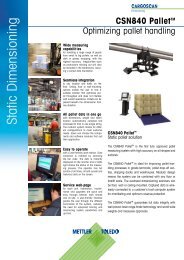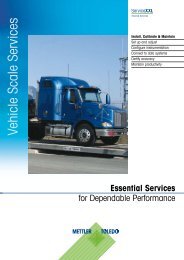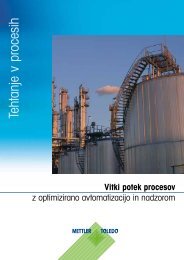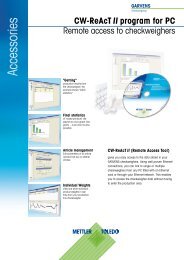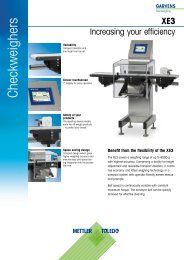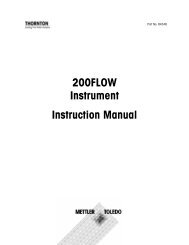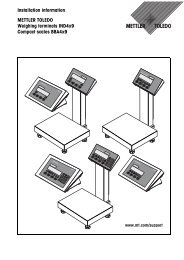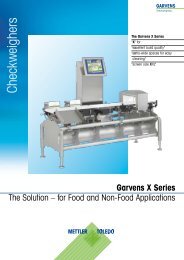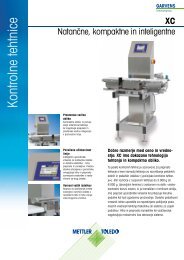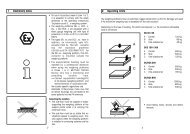Analyzing Petroleum Wax According to ASTM D 4419 - METTLER ...
Analyzing Petroleum Wax According to ASTM D 4419 - METTLER ...
Analyzing Petroleum Wax According to ASTM D 4419 - METTLER ...
Create successful ePaper yourself
Turn your PDF publications into a flip-book with our unique Google optimized e-Paper software.
DSC<strong>Analyzing</strong> <strong>Petroleum</strong> <strong>Wax</strong><strong>According</strong> <strong>to</strong> <strong>ASTM</strong> D <strong>4419</strong>The <strong>ASTM</strong> D <strong>4419</strong> standard describes the conditions for measuringtransition temperatures of petroleum waxes using differential calorimetryscanning (DSC). The transition temperatures provide petrochemicaltesting labora<strong>to</strong>ries with important information on the quality of petroleumderivatives while the melting peak assists with the characterizationand analysis of petroleum wax.PublisherMettler-Toledo AGLabora<strong>to</strong>ry & Weighing TechnologiesIm LangacherCH-8606 Greifensee, SwitzerlandProductionSegment Marketing LABSwitzerlandTechnical articlesMettler-Toledo AG– Labora<strong>to</strong>ry & Weighing Technologies– Analytical Instruments11794319 40.12DSC is a fast, convenient and reliablethermal analysis technique used for determiningthe characteristic temperaturesof a wax during transitions. Thehighest temperature transition is a solidliquidtransition associated with completemelting. This transition provides a guidefor choosing the most suitable s<strong>to</strong>rageand application temperatures. The solidliquidtemperature transition yields informationon the properties of the solid, suchas hardness and blocking temperature.Determining TransitionTemperatures Using DSCThe DSC 1 is a fully au<strong>to</strong>mated andversatile <strong>to</strong>ol that can be used <strong>to</strong> accuratelymeasure transition temperaturesof oil/wax mixtures. The example inFigure 1 demonstrates melting behavior.Five known and two unknown oil/waxmixture samples were pre-melted, stirredand cooled under controlled conditions.Samples were then heated from –60 °C <strong>to</strong>80 °C at 5 K/min <strong>to</strong> determine the transitiontemperatures. The results were evaluatedusing the STAR e software and displayedtypical melting behavior with peakmelting temperatures between 46 and57 °C. The two unknown samples couldalso be identified as the DSC curves werecharacteristic for petroleum wax.The oil content of the two unknown sampleswas estimated using a calibrationcurve. This was done by plotting the fiveknown oil contents as a function of themelting enthalpy. Figure 2 shows the excellentlinear relationship between the oilcontent and the overall melting enthalpy.The unknown oil contents of samples 6and 7 (Figure 1) were estimated <strong>to</strong> be22.4% and 0.6%.The fully au<strong>to</strong>mated and versatile DSC 1is an excellent <strong>to</strong>ol for measuring transitiontemperatures of petroleum wax. Withthe wide temperature range, accuracy andoutstanding measurement performance,the DSC 1 offers great benefits <strong>to</strong> the petrochemicaltesting labora<strong>to</strong>ry.} www.mt.com/dscSubject <strong>to</strong> technical changes.© Mettler-Toledo AG 08/01Printed in Switzerland. <strong>METTLER</strong> TOLEDO Testing Labs News 3
Figure 1. Melting of oil/wax mixtures.DSC 1Figure 2. Correlation of enthalpy versus oil contentin oil/wax mixtures.<strong>METTLER</strong> TOLEDO Testing Labs News 3



